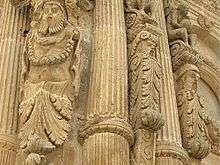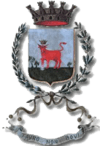Nardò
| Nardò | ||
|---|---|---|
| Comune | ||
| Comune di Nardò | ||
|
18th century column in Piazza Salandra | ||
| ||
.svg.png) Nardò within the Province of Lecce | ||
 Nardò Location of Nardò in Italy | ||
| Coordinates: 40°10′47″N 18°02′00″E / 40.17972°N 18.03333°E | ||
| Country | Italy | |
| Region | Apulia | |
| Province / Metropolitan city | Lecce (LE) | |
| Frazioni | Boncore, Cenate, Pagani, Palude del Capitano, Portoselvaggio, Roccacannuccia, Santa Caterina, Sant'Isidoro, Santa Maria al Bagno, Torre Inserraglio, Torre Uluzzo, Villaggio Resta | |
| Government | ||
| • Mayor | Giuseppe Mellone | |
| Area | ||
| • Total | 190 km2 (70 sq mi) | |
| Elevation | 45 m (148 ft) | |
| Population (1 January 2014)[1] | ||
| • Total | 31,862 | |
| • Density | 170/km2 (430/sq mi) | |
| Demonym(s) | Neretini | |
| Time zone | CET (UTC+1) | |
| • Summer (DST) | CEST (UTC+2) | |
| Postal code | 73048 | |
| Dialing code | 0833 | |
| Patron saint | St. Gregory the Illuminator | |
| Saint day | February 20 | |
| Website | Official website | |
Nardò is a town and comune in the southern Italian region of Apulia, in the province of Lecce. In 2014, it had a population of 20,766.[1]
History

Traces of human presence in the area dates from Palaeolithic times. The settlement was founded by the Messapi around the year 1000 BC. The Romans conquered it in 269 BC and built the Via Traiana through it. After the fall of the Western Empire it was under the Byzantines and the Lombards.
In 1055 the Normans captured Nardò. Their heirs were ousted by the Angevines in 1266. In 1497 the Aragonese gave it to Andrea Matteo Acquaviva, whose son Belisario was the first Duke of Nardò, and promoted the Renaissance in the city.
In 1647 the city rebelled against the Spanish domination, but the viceroyal troops suppressed the riot with heavy terms.
Geography
Overview
Part of Salento, Nardò is located in the north-western area of the province, by the Ionian Sea. The municipality borders with Avetrana (TA), Copertino, Galatina, Galatone, Leverano, Porto Cesareo, Salice Salentino and Veglie.
Frazioni
The town counts 11 hamlets(frazioni): Boncore, Cenate, Pagani, Palude del Capitano, Portoselvaggio, Roccacannuccia, Santa Caterina, Sant'Isidoro, Santa Maria al Bagno, Torre Inserraglio, Torre Uluzzo and Villaggio Resta.

Demographics

Nardò DOC
The area around Nardò produces red and rose Italian DOC wines. The grapes are limited to a harvest yield of 18 tonnes/ha with the finished needing a minimum alcohol level of 12.5%. The wines are primarily composed of 80-100% Negroamaro with Montepulciano and Malvasia Nera permitted to fill in the remaining 20%.[2]
Main sights
- The Piazza Salandra is the center of the town.
- Nardò Cathedral, built around 1000 AD. It has an 18th-century façade, but the interior has maintained the Romanesque-Gothic original appearance.
- Church of San Domenico (16th-18th centuries). It has a highly decorated façade with Baroque caryatids, columns and vegetable figures.
- Chiesa del Carmine, with a fine Renaissance portal.
- Church of San Cosimo (1618)
- Temple of the Osanna (1603)
- Nardò Ring in Nardò is used as a test track for driving at high speeds.
Personalities
- Daniele Greco, triple jumper
- Fabrizio Miccoli, footballer
- Giuliano Sangiorgi, singer-songwriter
Sister cities
See also
References
External links
- (Italian) Official website
- Views of the Baroque land of Nardò
- Useful information and contacts about Nardò
- How to get to Nardò
- Puglia Photo Gallery
- Nardò coast live webcam
- Salento (Italian)
| Wikimedia Commons has media related to Nardò. |
